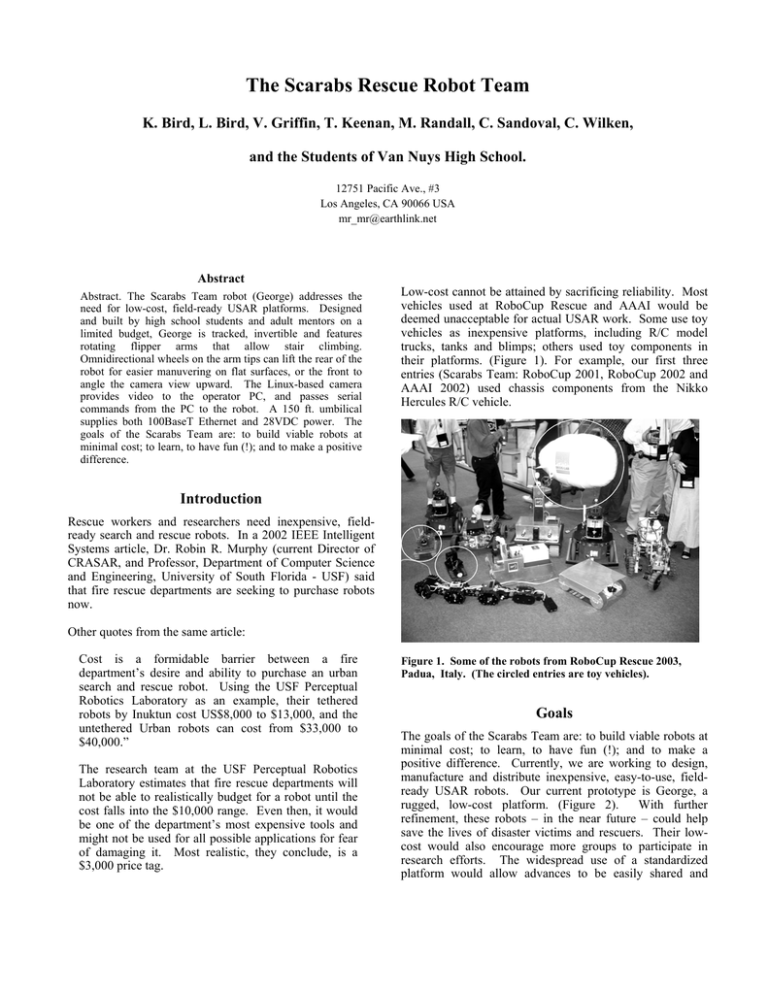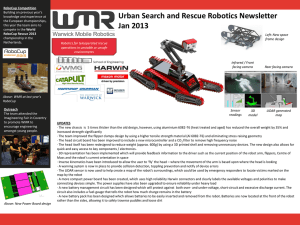The Scarabs Rescue Robot Team
advertisement

The Scarabs Rescue Robot Team K. Bird, L. Bird, V. Griffin, T. Keenan, M. Randall, C. Sandoval, C. Wilken, and the Students of Van Nuys High School. 12751 Pacific Ave., #3 Los Angeles, CA 90066 USA mr_mr@earthlink.net Abstract Abstract. The Scarabs Team robot (George) addresses the need for low-cost, field-ready USAR platforms. Designed and built by high school students and adult mentors on a limited budget, George is tracked, invertible and features rotating flipper arms that allow stair climbing. Omnidirectional wheels on the arm tips can lift the rear of the robot for easier manuvering on flat surfaces, or the front to angle the camera view upward. The Linux-based camera provides video to the operator PC, and passes serial commands from the PC to the robot. A 150 ft. umbilical supplies both 100BaseT Ethernet and 28VDC power. The goals of the Scarabs Team are: to build viable robots at minimal cost; to learn, to have fun (!); and to make a positive difference. Low-cost cannot be attained by sacrificing reliability. Most vehicles used at RoboCup Rescue and AAAI would be deemed unacceptable for actual USAR work. Some use toy vehicles as inexpensive platforms, including R/C model trucks, tanks and blimps; others used toy components in their platforms. (Figure 1). For example, our first three entries (Scarabs Team: RoboCup 2001, RoboCup 2002 and AAAI 2002) used chassis components from the Nikko Hercules R/C vehicle. Introduction Rescue workers and researchers need inexpensive, fieldready search and rescue robots. In a 2002 IEEE Intelligent Systems article, Dr. Robin R. Murphy (current Director of CRASAR, and Professor, Department of Computer Science and Engineering, University of South Florida - USF) said that fire rescue departments are seeking to purchase robots now. Other quotes from the same article: Cost is a formidable barrier between a fire department’s desire and ability to purchase an urban search and rescue robot. Using the USF Perceptual Robotics Laboratory as an example, their tethered robots by Inuktun cost US$8,000 to $13,000, and the untethered Urban robots can cost from $33,000 to $40,000.” The research team at the USF Perceptual Robotics Laboratory estimates that fire rescue departments will not be able to realistically budget for a robot until the cost falls into the $10,000 range. Even then, it would be one of the department’s most expensive tools and might not be used for all possible applications for fear of damaging it. Most realistic, they conclude, is a $3,000 price tag. Figure 1. Some of the robots from RoboCup Rescue 2003, Padua, Italy. (The circled entries are toy vehicles). Goals The goals of the Scarabs Team are: to build viable robots at minimal cost; to learn, to have fun (!); and to make a positive difference. Currently, we are working to design, manufacture and distribute inexpensive, easy-to-use, fieldready USAR robots. Our current prototype is George, a rugged, low-cost platform. (Figure 2). With further refinement, these robots – in the near future – could help save the lives of disaster victims and rescuers. Their lowcost would also encourage more groups to participate in research efforts. The widespread use of a standardized platform would allow advances to be easily shared and was done at Van Nuys High School in Van Nuys, California. Van Nuys High School is designated Title 1, which means over 65% of their students receive school lunch tickets. Even so, they have a well-equipped machine shop, including CNC machines, plasma cutters, mills, lathes, etc. They have been involved in US FIRST high school robotics competitions for several years (www.usfirst.org), as well as other projects, including ours. Under the guidance of instructor Charles Wilken and Team Coordinator Michael Randall, the Van Nuys students and team members Kevin Bird and Bob Fooroghi, built George, Jr. in FOUR DAYS; it placed 5th at RoboCup 2003. (Figures 3, 4). All this has been done as a learning opportunity. Figure 2. platform. CAD rendering of George, a low-cost SAR implemented, both with other researchers and fire departments, accelerating research and further improving the rescuers’ effectiveness and safety. And researchers, freed from platform and sensor development, could focus on higher-level behaviors including collaboration, autonomy, planning, knowledge representation, and perception. Background To date, our efforts have been primarily funded out-ofpocket. Fueled by our passion for robotics, and our desire to make a positive difference in the world, we combine creativity, common sense, technical expertise, commercially-available components, and over four years of first-hand experience earned at RoboCup and AAAI competitions to create robots that get the job done for the lowest cost. Fig. 4. Students testing George, Jr. Most of the machine work to build the George platform was Features Operator Station Set-up and Break-Down Our operator interface consists of a laptop computer and a joystick. One person should be able to set up in under five minutes, including booting the user interface program. Communications Figure 3. George Jr. SAR robot, “rescuing” a “baby” at RoboCup 2003, Padua, Italy. We have learned through firsthand experience, observations and WTC field reports the failings of wireless communications. Our robot communications are via a 150 ft. tether, providing both 100BaseT Ethernet and 28VDC power. Control Method and Human-Robot Interface Team Training for Operation (Human Factors) One operator will control the robot via a laptop PC interface. All functions will be accessed with a single joystick.. The on-screen display provides live high-quality video, robot position, and status. Our experience from RoboCup 2003 in Padua showed that very little practice was needed to control the George, Jr. robot effectively. The George platform uses the same video camera, and an improved user interface. Estimating robot / victim / obstacle position poses the greatest challenge; however, this task will be automated with the addition of navigational sensors. Map generation/printing The laptop computer generates a map of the robot’s position, based on operator input. The operator can, via the keyboard, mark the location of victims, obstacles, etc. on the map. The map can be viewed onscreen, or output to a printer. With future upgrades, maps will be generated automatically from sensor data. Sensors for Navigation and Localization Currently, the only sensor used for navigation is the video camera. . However, the chassis can accommodate an onboard Mini-ITX PC. This will provide: • multiple camera interfaces; • onboard vision / sensor processing (including visionbased navigation); • possible semiautonomous / autonomous operation. Other sensors can also be interfaced via the onboard microcontroller, including infrared distance, ultrasonic distance, microwave velocimeter, odometers and inertial guidance. Sensors for Victim Identification Victim identification is done with the video camera and a passive infrared detector for sensing body heat. The MiniITX PC would provide two-way audio capabilities (listening for cries of help, and asking victims questions to ascertain their condition). Other sensors could include: CO2, blood oxygen levels, pulse rate, respiration rate, etc. Robot Locomotion Lessons learned by robot USAR teams at the World Trade Center (as reported at the RoboCup 2002 Symposium) were incorporated into George, including tracked design (using 50 mm wide automotive timing belts as treads), and invertible operation. Other Mechanisms George was designed from the beginning to climb stairs. Motorized arms will lift the robot over obstacles and onto stairs. Leaving the arms extended will stabilize the robot going up stairs or over rough terrain. When the arms are rotated back, omnidirectional wheels on the arms will lift most of the tread off the floor; this provides low-friction steering on flat surfaces. Or the arms can lift the front of the robot, angling the camera view upward. Finally, the arms can be used to right the platform if it flips over. Possibility for Practical Application to Real Disaster Site Our focus is to produce a field-ready platform. The George design is very close to this. Field tests under dry, ambient conditions could proceed, and will be attempted at the earliest opportunity: the Los Angeles Fire Dept. Bureau of Emergency Services has a USAR training course in Sherman Oaks, CA (a 30-minute drive). Personnel there have been contacted, and are willing to discuss a USAR robot demonstration there. System Cost Cost to build one robot is estimated at $5,000: • Mechanical -- $1,000. (Drivetrain components from Stock Drive Products / Sterling Instruments); • Electronics -- $1,000. (Video camera from Axis Communications, microcontrollers from Cypress Semiconductor Corporation); • Motors / controllers -- $1,000. (Two drive motors from Maxon, two arm motors from Engel, custom-built motor drivers); • User interface -- $1,000. (A laptop, joystick and custom software); • Electrical -- $500. (Cable from Genesis Cable Systems, DC power supply from Condor D.C. Power Supplies, Inc.); • Misc. hardware, connectors, carrying case, etc: $500. In full production, components would be manufactured / acquired at volume discounts, significantly reducing cost. Conclusion Affordable, rugged USAR robots are needed now, both to save lives, and forward research. Our prototype robot is close to meeting the needs of both communities in the near future, thanks to the hard work and creativity of high school students and their mentors. References Angela Davids. 2002. Urban Search and Rescue Robots: From Tragedy to Technology. IEEE Intelligent Systems March/April 8183. Blitch, J. 2002. A Research and Development Vision for Robot Assisted Search and Rescue. RoboCup 2002 Symposium.



